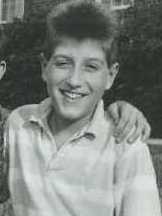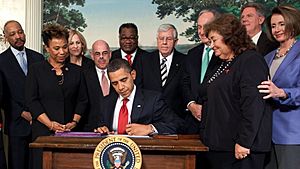Ryan White facts for kids
Quick facts for kids
Ryan White
|
|
|---|---|

White in 1989
|
|
| Born |
Ryan Wayne White
December 6, 1971 Kokomo, Indiana, U.S.
|
| Died | April 8, 1990 (aged 18) Indianapolis, Indiana, U.S.
|
| Cause of death | AIDS-related pneumonia |
| Resting place | Cicero Cemetery Cicero, Indiana |
| Occupation | Student |
| Parent(s) | Jeanne Elaine Hale (mother) Hubert Wayne White (father) |
Ryan Wayne White (December 6, 1971 – April 8, 1990) was an American teenager from Kokomo, Indiana. He became a national symbol for people living with HIV/AIDS in the United States. This happened after his school tried to stop him from attending classes because he had AIDS.
Ryan got HIV from a blood treatment for his hemophilia, a blood disorder. When he was diagnosed in December 1984, doctors thought he only had six months to live. Even though doctors said he was not a risk to other students, many people did not understand AIDS well at that time.
When Ryan tried to go back to school, many parents and teachers in Howard County protested. They were worried the disease would spread. News of this conflict made Ryan a well-known person and an advocate for AIDS research and public education. Ryan lived five years longer than doctors expected. He died on April 8, 1990, just one month before his high school graduation.
After Ryan's death, the U.S. Congress passed an important law called the Ryan White CARE Act. This law helps people living with HIV/AIDS in the United States. Ryan White programs are now the largest providers of services for people with HIV/AIDS in the country.
Contents
Ryan White's Early Life and Health Challenges
Ryan White was born in Kokomo, Indiana. When he was three days old, doctors found out he had severe hemophilia A. This is a condition where blood does not clot properly. Even small injuries could cause serious bleeding for Ryan. To treat this, he received weekly infusions of factor VIII. This is a blood product made from the plasma of many different people.
How Ryan Contracted HIV
Ryan was healthy for most of his childhood. But in December 1984, he became very sick with pneumonia. On December 17, 1984, doctors diagnosed him with AIDS. Ryan had received a factor VIII treatment that was infected with HIV. Thousands of other people with hemophilia around the world also got HIV this way.
At that time, the virus that causes AIDS had only recently been found. Much of the pooled factor VIII concentrate was tainted. Blood banks later started screening and heat-treating blood products. This helped to deactivate HIV and other viruses. Doctors predicted Ryan had only six months to live.
After his diagnosis, Ryan was too sick to go to school. But by early 1985, he started to feel better. His mother asked if he could return to school. However, school officials said he could not. On June 30, 1985, the school superintendent officially denied his request. This started a long legal process.
Ryan's Fight to Attend School
Western Middle School in Russiaville faced strong pressure from parents and teachers. They wanted to stop Ryan from returning to school after his diagnosis became known. Out of 360 students, 117 parents and 50 teachers signed a petition to ban Ryan. Because of widespread fear and lack of understanding about AIDS, the school principal and then the school board agreed to prohibit him.
The White family filed a lawsuit to overturn this decision. On November 25, an Indiana Department of Education officer ruled that Ryan must be allowed to attend school. This ruling followed health guidelines.
Misunderstandings About HIV Transmission
In the mid-to-late 1980s, people did not fully understand how HIV spread. Many believed it could easily spread through everyday contact. Children with AIDS were very rare, which added to the fear. When Ryan was allowed to return to school for one day in February 1986, 151 out of 360 students stayed home. Ryan also worked as a paperboy. Many people on his route canceled their newspaper subscriptions. They thought HIV could be passed through newsprint.
Health experts, including the Indiana state health commissioner and the Centers for Disease Control and Prevention, told the school board that Ryan posed no risk. But the school board and many parents ignored them. A study published in February 1986 showed that the risk of infection was "minimal to nonexistent" even with close contact.
When Ryan was finally allowed back in April, some families took their children out of school. They started a different school. The Kokomo Tribune newspaper supported Ryan. Its editors and publishers were criticized and even threatened for their actions.
Moving to a New School
Ryan attended Western Middle School for eighth grade during the 1985–1986 school year. He was very unhappy and had few friends. The school made him use disposable utensils and separate bathrooms. They also excused him from gym class. Threats continued. After a bullet was fired through their living room window, the family decided to leave Kokomo.
After finishing the school year, his family moved to Cicero, Indiana. Ryan started ninth grade at Hamilton Heights High School. On August 31, 1986, Ryan was nervous but was welcomed by the principal and superintendent. Some students who had learned about AIDS were not afraid to shake his hand.
Ryan Becomes a National Voice
Ryan White's story gained a lot of attention. Between 1985 and 1987, news stories about AIDS in American media doubled. While he was isolated in middle school, Ryan often appeared on national television and in newspapers. He talked about his struggles with the disease. He became known as a symbol for the AIDS crisis. He helped with fundraising and educational campaigns.
Ryan took part in many public events for children with AIDS. Many famous people became his friends. These included singers John Mellencamp, Elton John, and Michael Jackson. Actor Matt Frewer, diver Greg Louganis, President Ronald Reagan and First Lady Nancy Reagan, and basketball stars Bob Knight and Kareem Abdul-Jabbar also befriended him.
Ryan often appeared on Phil Donahue's talk show. His favorite actress, Alyssa Milano, met him and gave him a friendship bracelet. Elton John helped Ryan's family buy a house. Michael Jackson gave Ryan a red 1988 Ford Mustang. Despite his fame and gifts, Ryan said he did not like the public spotlight. He wished he could trade his fame for freedom from the disease.
In 1988, Ryan White spoke to the President's Commission on the HIV Epidemic. He shared how he faced discrimination at first but how education made him welcome in Cicero. Ryan used his experiences in Kokomo and Cicero to show how important AIDS education was.
In 1989, ABC aired a TV movie called The Ryan White Story. Lukas Haas played Ryan, and Judith Light played his mother. Ryan White had a small role in the film as another boy with HIV.
By early 1990, Ryan's health was getting worse quickly. In his last public appearance, he hosted a party with former president Ronald Reagan and Nancy Reagan. Even though he was sick, Ryan talked to the Reagans about his prom date and his hopes of going to college.
Ryan White's Passing
On March 29, 1990, Ryan White went to Riley Hospital for Children in Indianapolis. He had a serious lung infection. As he got sicker, he was put on a ventilator. Elton John visited him, and the hospital received many calls from people wishing him well. Ryan White died on April 8, 1990.
Over 1,500 people attended Ryan's funeral on April 11. It was held at the Second Presbyterian Church in Indianapolis. His pallbearers included Elton John, football star Howie Long, and Phil Donahue. Elton John performed a song called "Skyline Pigeon". Singer Michael Jackson, future U.S. President Donald Trump, and then-First Lady Barbara Bush also attended.
On the day of the funeral, Ronald Reagan wrote a tribute to Ryan in The Washington Post. Reagan's words about AIDS and Ryan's funeral showed how much Ryan White had changed people's views on AIDS.
Ryan is buried in Cicero, Indiana. In the year after his death, his grave was vandalized four times. Over time, Ryan's grave became a special place for his admirers.
Ryan White's Lasting Impact
Ryan White was one of a few well-known people with AIDS in the 1980s and early 1990s. He helped change how the public saw the disease. Ryan helped people understand that HIV/AIDS was a serious health crisis.
Many charities were started after Ryan's death. The Indiana University Dance Marathon, which began in 1991, raises money for the Riley Hospital for Children. This event has raised over $50 million for children at Riley. The money also helps fund the Ryan White Infectious Disease Clinic at the hospital. Ryan's personal doctor, Dr. Martin Kleiman, became the Ryan White Professor of Pediatrics at Indiana University School of Medicine.
In 1992, Ryan's mother started the Ryan White Foundation. This group worked to raise awareness about HIV/AIDS, especially for people with hemophilia and families caring for sick relatives. The foundation was active throughout the 1990s. In 2000, Ryan's mother closed the foundation and joined a larger charity called AIDS Action. She continued to be a spokesperson for AIDS activism. Ryan's high school, Hamilton Heights, holds an annual AIDS Walk. The money raised goes to a Ryan White Scholarship Fund.
Elton John donated money from his song "The Last Song" to a Ryan White fund. Michael Jackson dedicated his song "Gone Too Soon" to Ryan. Singer Tiffany also dedicated her song "Here in My Heart" to him.
In November 2007, The Children's Museum of Indianapolis opened an exhibit called "The Power of Children: Making a Difference". This exhibit features Ryan's bedroom and belongings. It also honors Anne Frank and Ruby Bridges. After Ryan died, Greg Louganis gave his Olympic gold medal to Ryan's mother. It is now part of the display about Ryan at the Children's Museum.
The Ryan White CARE Act

In August 1990, four months after Ryan White died, Congress passed The Ryan White Comprehensive AIDS Resources Emergency (CARE) Act. This law was named in his honor. It is the United States' largest government-funded program for people living with HIV/AIDS. The Ryan White CARE Act helps pay for care for low-income, uninsured, and underinsured people with AIDS and their families.
Ryan White programs are "payers of last resort." This means they help pay for treatment when no other money is available. The law has been updated several times and is still active today. The program helps about 500,000 people each year. It also provides money and support to local and state healthcare providers.
What Ryan White Said
- "I came face to face with death at thirteen years old."
- "I received thousands of letters of support from all around the world, all because I wanted to go to school."
- "AIDS can destroy a family if you let it, but luckily for my sister and me, Mom taught us to keep going. Don't give up, be proud of who you are, and never feel sorry for yourself."
- "Given six months to live and being the fighter that I am, I set high goals for myself."
See also
 In Spanish: Ryan White para niños
In Spanish: Ryan White para niños
- Eve van Grafhorst – an Australian child who got HIV from a blood transfusion and was banned from her preschool.

